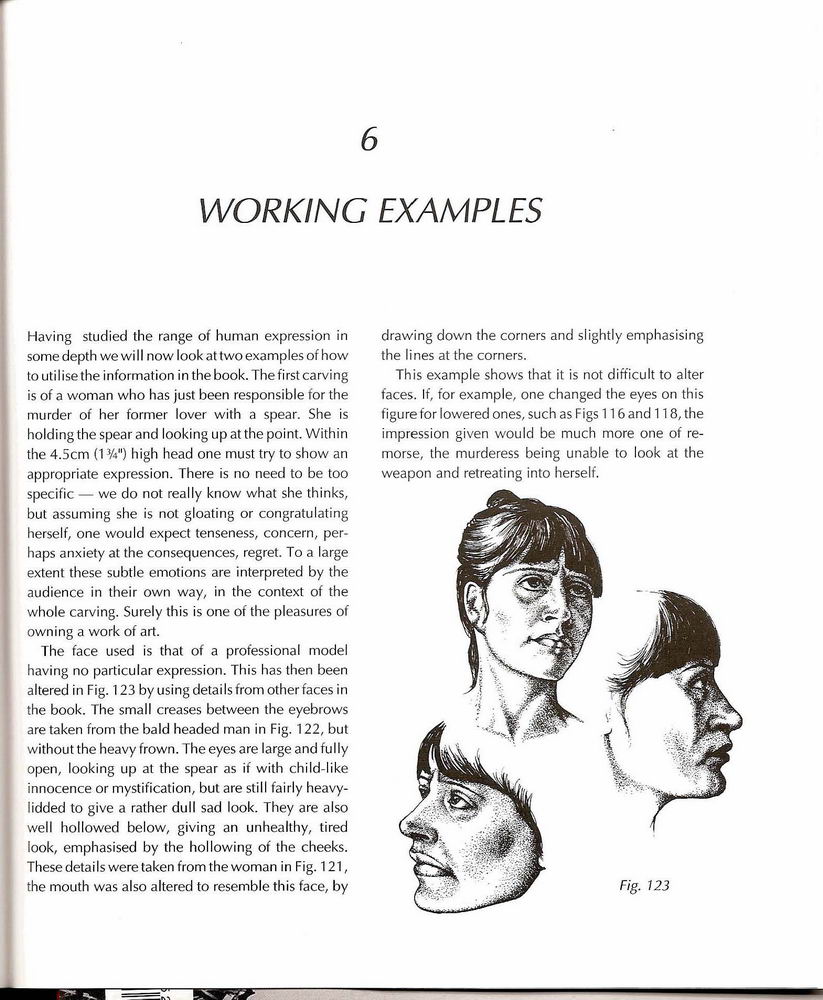carvingúcea

r
6
WORKING EXAMPLES
Having studied the rangÄ™ o i human expression in some depth we wi II now look at Iwo examples o f how to utilise the information in the book. The first carving
Iis of a woman who has just been responsible tor the miirder of her former lover with a spear. She is holding the spear and looking up at the point. Within the 4.5cm (1 }/Å‚") high head one must try to show an appropriate expression. There is no need to be too
Ispecific — we do not really know what she thinks, but assuming she is not gloating or congratulating herself, one would expect tenseness, concern, per-haps anxiety at the consequences, regret. To a large
|extent these subtle emotions are interpreted by the audience in their own way, in the context of the whole carving. Surely this is one of the pleasures of owning a work of art.
The face used is that of a professional model having no particular expression. This has then been altered in Fig. 123 by using detailsfrom other faces in the book. The smali creases between the eyebrows are taken from the bald headed man in Fig. 122, but without the heavy frown. The eyes are large and fully
Iopen, looking up at the spear as if with child-like innocence or mystification, but are still fairly heavy-lidded to give a rather duli sad look. They are also well hollowed be Iow, giving an unhealthy, tired look, emphasised by the hollowing of the cheeks. These details were taken from the woman in Fig. 121, the mouth was also altered to resemble this face, by drawing down the corners and slightly emphasising the lines at the corners.
This example shows that it is not difficult to alter faces. If, for example, one changed the eyes on this figurÄ™ for lowered ones, such as Figs 116 and 118, the impression given would be much morÄ™ one of re-morse, the murderess being unable to look at the weapon and retreating into herself.


Wyszukiwarka
Podobne podstrony:
carving?ce8 38 RangÄ™ of Expressions In the carving, Fig. 79, al-though the top half ot the face is c
carving?ce4 34 RangÄ™ of Expressions In the tace of Falstaff, Fig. 70, these reactions are the only s
14937 stronaQ (3) â– Vocabulary I adjectives to describe places 6 a Which adjectives can we use with
concentranons, in the cotyledons at the 4 lowcr concentrations and in ‘ La h on tan buds and coryle
carving?ce0 3 O RangÄ™ of Expressions HAPPY Referring now to the same people smilin
carving?ce2 32 RangÄ™ of Expressions These studies show a grinning face carved in wal-nut, Fig. 65, a
carving?ce3 RangÄ™ of Expressions The young boy, Figs 68 and 69. is a natural smiler. Notice t
carving?ce6 3 6 RangÄ™ of Expressions SADNESS These two studies, Figs 75 and 77, ar
carving?ce9 RangÄ™ of Expressions 39 Figs 80-81 ANGER Figs 80 and 81 show the face of aggression in w
carving?ceH 48 RangÄ™ of Expressions The Masai warrior Fig. 96 and Ozymandias, the Egyptian king, Fig
carving?ceP 5 O RangÄ™ of Expressions DETERMINATION Fig. 101 depicts the Gallic war
carving?ceV RangÄ™ of Expressions The traces of concern on the Masa i warrior s face, Fig. 114, indic
carving?ceX RangÄ™ of Expressions Figs 119-120 The face of the teenage girl, Figs 119 and 120, shows
więcej podobnych podstron